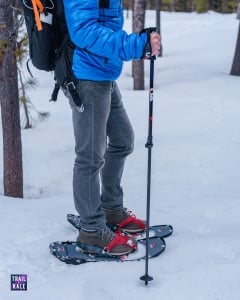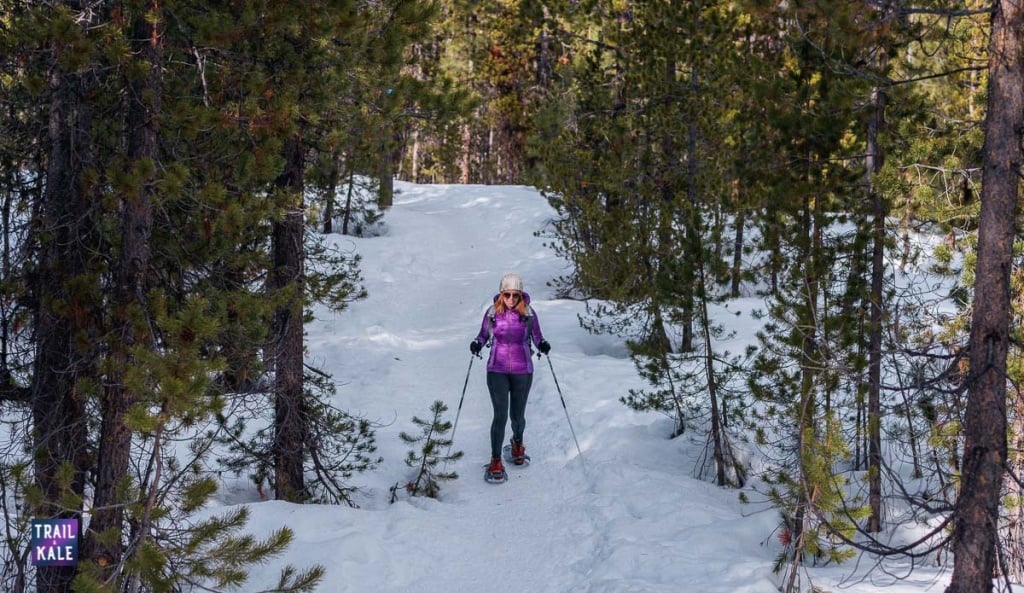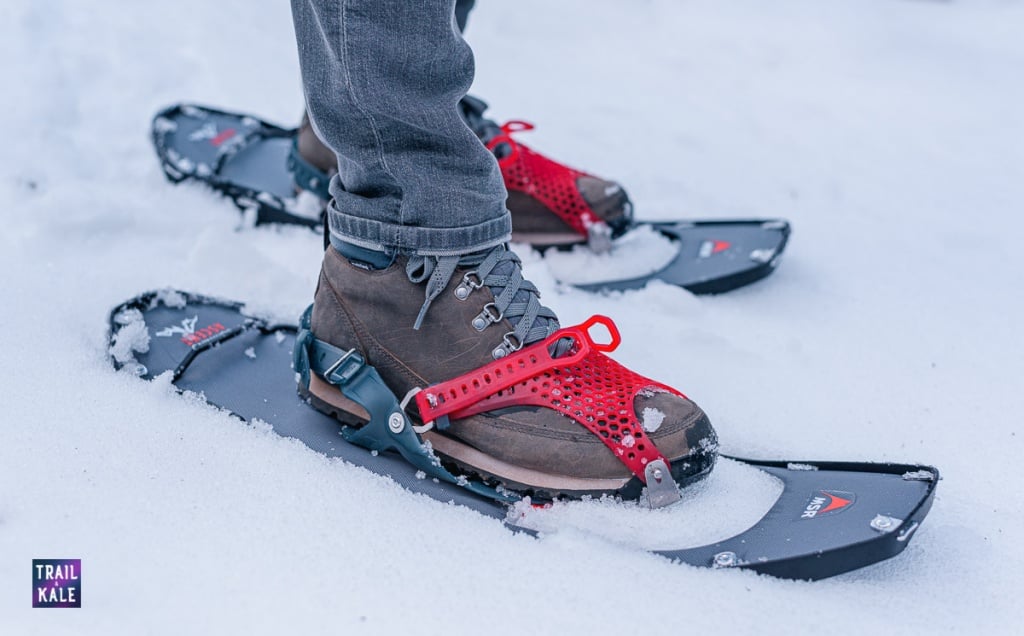Much like hiking, snowshoeing is one of those great activities that are easily accessible, provided you have a few key items of gear, which I’ll get into later on in this in-depth beginner’s guide to snowshoeing. What’s more, snowshoe hiking can be done at any age, alone or with friends/family and you don’t need any prior experience or special skills to be able to have an enjoyable mini-adventure.
There are of course some things that you need to know, including what snowshoes are best for the type of snowshoeing you intend to do, how to snowshoe and how to choose snowshoes as well as what boots or shoes to wear snowshoeing, in order to make your snowshoeing efficient and fun.
A big thank you to REI for partnering with us for this article and in doing so, helping us bring you the best-informed snowshoeing advice.
Beginner’s Guide to Snowshoeing: Table of Contents
- What is snowshoeing and why should you try it?
- How to snowshoe (techniques and tips)
- How to find the best snowshoes for you
- What shoes, boots and clothes to wear snowshoeing
- How to snowshoe – 5 simple tips to get started
- How to find places near you to go snowshoeing
What is snowshoeing and why should you try it?
Snowshoeing is effectively hiking but with snowshoes that are able to distribute your weight over a larger surface area, allowing you to hike over deep snow without sinking. They also provide much more traction than any hiking boots can. This is why snowshoeing is also sometimes called snow shoe hiking, because most people treat a snowshoeing trip similiarly to a hiking trip in terms of where you go and what you take with you.
Snowshoeing is an excellent way to keep fit during those deep winter months where your favorite hiking trails are covered in snow. Snowshoes can also be useful as a means to seek out harder to reach, less crowded, snow-covered trails during summer months. Here are some reasons why you should give it a try.
Snowshoeing doesn’t require much gear
To go snowshoeing all you really need is a good pair of snowshoes, some winter boots, warm yet breathable hiking clothes, and some snowshoe poles to help with balance should you feel you need it. If you want to try before you buy, REI stores can rent you snowshoes and poles.
Anyone can snowshoe
Once you have learned the basic snowshoeing techniques you will know how to snowshoe and be ready to go and enjoy it. Essentially, if you can walk and learn these basic techniques then you can snowshoe on an easy, fairly flat trail with few obstacles, and it can be as mellow as a gentle summer hiking trip would be.
If you plan on going snowshoeing on technical trails that are not flat then there are a few more considerations, for example you’ll need to learn how to go up and down hills while using your poles to keep you upright, how to get up if you fall in deep snow or on a steep gradient, and how to avoid and prepare for avalanches. Taking a class or going on a tour with REI is a great way to learn these snowshoeing concepts.
You can even go snowshoe running if you have the right snowshoes
It’s also possible to go running in snowshoes, provided they are lightweight and running specific, which means they’ll have:
- spring-loaded bindings for a quick return
- a lightweight construction to reduce muscle fatigue
- a narrow-waisted frame to allow for a natural running stride
An example of good snowshoes for running is the Atlas Run Snowshoes available at REI. Snowshoe running could be a great way to get some intense cardio outside if you live somewhere that is too cold and snowy/icy to run on your regular trails or roads during winter.
Snowshoeing is really good fun!
Maybe I should have put this as the number 1 reason to learn how to snowshoe! At first glance, you may not think it but once you give snowshoeing a chance I think you’ll be surprised how fun it is to be able to walk over terrain that you may otherwise never be able to.
How to find the best snowshoes for you
Before you get started, there are a few key items that you will need in order to have an enjoyable snowshoeing experience.
How to choose snowshoes
Well, this depends on the type of snowshoeing you plan to do. There are 4 key features of snowshoes, plus your own physiology to consider when choosing the right ones for you, and the type of snowshoeing you plan on doing:
- the frame and deck which allows you to float over snow (a snowshoe feature)
- the bindings which secure your feet to the deck/frame (a snowshoe feature)
- the crampons underneath which provide traction, even on ice (a snowshoe feature)
- flip-up heel lifts for steep ascents (a snowshoe feature)
- Your total body and pack weight combined (your physiology)
With these in mind, a snowshoe with larger deck (or surface area) will allow you to float more on top of the snow, while snowshoes with smaller decks will sink more in powder. So, a heavier person may go for a larger deck size but the caveat of that is the snowshoes will be heavier, larger and less maneuverable.
Heel lifts keep your feet level whilst going uphill, making ascents much easier, and less cumbersome by reducing calf fatigue and keeping your weight more evenly distributed over the snowshoe. This is the same technique used on ski-touring/backcountry ski bindings.
There are also women’s snowshoes which generally come with a narrower deck and can accommodate smaller shoe sizes. If you’re still not sure which snowshoes to buy then definitely consider going into REI and renting some to try out. Alternatively, REI does offer a very good returns service when you buy online and try on at home.
What to wear snowshoeing
Winter hiking boots that will keep your feet warm and dry
Because most snowshoes are designed to be worn over a pair of hiking shoes or boots, you’ll need to wear a good pair of hiking boots in order to wear snowshoes. Hopefully you already have a pair of hiking boots that you can use – it definitely helps to make sure your boots are comfortable, warm, and waterproof.
Having waterproof boots to wear snowshoeing is important because although you’ll be wearing snowshoes and staying mostly on top of the snow, your boots will inevitably get covered in snow because the front of the snowshoe has an opening. This hole in the deck provides flexibility and movement to the tips of your boots while you walk, as demonstrated in our snowshoeing videos.
Wear warm winter hiking clothes snowshoeing
The best way to pack clothes to wear snowshoeing is to plan as if you’re going on a winter hike or even skiing.
How warm your clothing should really depend on the weather conditions where you intend to snowshoe. During our most recent snowshoe adventure, we chose a short and flat route, and the weather was fairly mild which meant we didn’t need to take all that much gear with us. An extra layer, gloves, trail snacks, and water were, however, in our packs.
If it’s especially cold where you will be going snowshoeing then you may want to wear something closer to what you would wear skiing, which would include more thermal layers.
Hiking poles for snowshoeing
Snowshoe poles help keep you balanced, allow your upper body muscles to take a portion of the effort away from your legs, and help give you rhythm while snowshoeing in powder or deep snow.

Snowshoe poles differ from trail running poles in that they should be adjustable in length, and require a large snowflake basket on the tips to stop them from sinking into deep snow. Adjustable pole length is important for hilly terrain. For example, if you’re going uphill then you want to have a shorter pole, and a longer pole length for the downhills. On flat terrain, a general sizing rule is that the pole length should allow your elbow and forearm to be comfortably parallel to the ground.
When I recommend running poles to runners I always say that they should be of a z-folding design so that they can pack down very small, which is great for trail running, but many of these are not adjustable in length. Snowshoeing poles adjust by sliding out with the telescopic design.
It is also recommended to have hand straps attached to the pole handles, this will take some effort away from your wrists over time and you’ll also have the benefit of not accidentally dropping and losing your poles in deep snow.
Here are some highly-rated snowshoe poles that are for sale at REI.
GPS Watch with navigation features
Depending on where you go snowshoing, trails can be quite disorienting when covered in snow. This is especially so in forests, where every direction you glance can look similar. This can make it easier to get lost than you think – even if you are familiar with the trails from hiking or running on them in summer. If other people have taken wrong turns before you this can be really misleading for you, too, as you may instinctively follow their tracks even through it’s not the right way!
Taking a GPS watch or handheld device snowshoeing is therefore something that is a good idea if you are going snowshoeing for the first time and especially if you are going somewhere new. Hopefully if you’re already a runner you own one, but if not it may be worth investing in one if you’re planning to take snowshoeing, hiking and/or trail running seriously.
To learn more about all the smart features that GPS watches have, and the ones we recommend, read this article: The best durable GPS Watches with navigation features and long battery life.
Avalanche Safety Gear
If you intend to go snowshoeing into the backcountry (steep mountain territory that could be prone to avalanche risk), then please consider taking an avalanche safety kit.
Avalanche safety kits are a cost-effective way of buying the entire set of gear necessary to keep yourself safe in areas that pose an avalanche risk. This gear consists of a shovel, locator beacon, and a probe.
Please also consider taking an avalanche safety class with REI which will only take a few hours to complete, they are free to attend. These courses are great fun, highly educational and an absolute must if you’re going to be heading into the backcountry whether for ski touring/backcountry skiing or snowshoeing. We did our avalanche safety class in Switzerland before our first Backcountry skiing adventure.
How to snowshoe (techniques and tips)
If you can hike, you can snowshoe which makes snowshoeing a really accessible activity for a huge range of people to do, including the whole family from kids, to grandparents. Yes, kids snowshoes do exist :).
Tip 1: Walk with legs parallel and pick your feet up high
Be mindful that snowshoes are much wider than hiking boots, and although snowshoeing is very similar to hiking there are certain adjustments to your stride that you should try to make. When you are snowshoeing try to keep your legs parallel with a wide stance as you walk with as little a stride ‘crossover’ as possible.
Also, make an effort to pick your feet up higher than you would when you normally walk, this will minimize any clipping of your snowshoes. I can see how some people may trip over accidentally by clipping their other snowshoe. See the video below for a demonstration on how to do this.
Tip 2: When turning, lift your leading leg high and rotate in the air
When you need to do a sharp 180-degree turn, lift your leading leg high in the air and rotate well before placing your foot on the ground. Due to the mechanics of snowshoes, the rear is not attached to your heel so it’s very easy to catch the rear of the deck in deep snow when making sharp turns. See the video below for a demonstration. This snowshoeing technique is quite similar to when you turn while ski-touring.
Tip 3: When snowshoeing uphill, use heel lifts
When the terrain gets super steep (in the uphill direction), you really need flip-out heel lifts on your snowshoes. Heel lifts help keep your feet level while going uphill which saves your calve muscles and helps to prevent you from falling backwards down the hill.
Tip 4: Beware the sharp metal crampons on the bottom of snowshoes
Metal crampons on the bottom of snowshoes provide superior traction over any winter hiking boots but they can also be dangerous if not respected. I learned this the hard way by cutting my finger on Helen’s snowshoes as I was loading up the car. It’s not just damaging your skin that you need to be mindful of, snowshoe crampons can also cut your clothing if they’re particularly sharp.

The snowshoes we use are MSR’s Lightning Ascent Snowshoes which are sharp but I don’t think they would damage clothing, never say never though!
Tip 5: Don’t even bother trying to walk backward in snowshoes
Yes some of the more agile amongst you may be able to walk backward in snowshoes, but do yourself a favor, don’t bother. Walking backward in snowshoes is a sure-fire way to fall flat on your peach.
How do I find the best places to go snowshoeing near me?
If you live in an area that has Sno-Parks available to you, then definitely head to one of them for your first snowshoeing experience. Check beforehand but you usually have to pay to use them but the trails are likely to be marked by name (and difficulty), well maintained, and easy to follow.
If you don’t have access to a Sno-Park then don’t worry, there is a really cool website and app called AllTrails which will show you, wait for it… ALL THE TRAILS in the region in which you intend to snowshoe. Check with locals or park ranger stations to make sure there’s actually a good amount of snow on the ground before heading out, whether it’s to a Sno Park or a trail on AllTrails. To find the best snowshoeing trails near you, all you have to do is:
- Visit the AllTrails website
- Click on Explore in the top left which will take you to your current region (if you have location services enabled for your web browser)
- Click on the ‘What to do‘ tab at the top
- Select snowshoeing and all the relevant trails will be shown on the map. Here’s an example of our local snowshoe trails as listed on AllTrails when we lived in Bend, Oregon: https://www.alltrails.com/explore/us/oregon/bend?a[]=snowshoeing
I hope you enjoyed reading this guide to snowshoeing for beginners and it has inspired you to give it a go! If you have a question for me, please leave it in the comments below. If you’re reading this towards the end of winter and feel there may not be enough snow left for snowshoeing this year but would like to try or do more hiking, then you can learn more about what you need to know to go hiking, including our essential hiking gear checklist, in our beginner’s guide to hiking!








![Stargazing for Beginners: The Ultimate Guide [Telescope Not Required] Stargazing for Beginners: The Ultimate Guide [Telescope Not Required]](https://www.trailandkale.com/wp-content/uploads/2019/11/Guide-to-Stargazing-for-Beginners-Trail-and-Kale-110x75.jpg)

